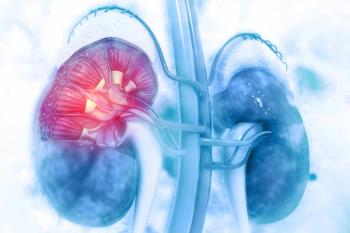
Pathology Aids in Diagnosis of Hereditary Leiomyomatosis, RCC
Suspicious pathology from kidney tumors was significantly associated with testing positive for fumarate hydratase mutations, which may aid in the early diagnosis of hereditary leiomyomatosis and renal cell carcinoma.
Suspicious pathology from kidney tumors was significantly associated with testing positive for fumarate hydratase mutations, which may aid in the early diagnosis of hereditary leiomyomatosis and renal cell carcinoma (HLRCC), according to the results of a study
“Patients with HLRCC may harbor clinically aggressive RCC and often present at a young age with advanced disease, as was true for our cohort,” wrote Ryan P. Kopp, MD, of the department of urology at Oregon Health and Science University, and colleagues. “Moreover, many patients with fumarate hydratase mutations and aggressive RCC do not have cutaneous leiomyomas to aid in the diagnosis. Our study demonstrates that prospective identification of special features by the pathologist and recognition by the clinician can have a substantial impact on the diagnosis of HLRCC.”
According to the study, the early identification of patients with HLRCC is important because patients with RCC are often diagnosed with advanced disease and at a younger age. Additionally, early identification allows for family screening for the syndrome. HLRCC often presents with identification of skin leiomyomas; however, pathologic assessment of renal tumors may help to identify patients with the underlying fumarate hydratase mutation, which causes the syndrome.
With this study, Kopp and colleagues evaluated if an association existed between prospectively identified HLRCC suspicious pathology and the presence of fumarate hydratase mutations among patients referred for genetic testing for the risk of hereditary cancer.
Twenty-nine patients underwent fumarate hydratase testing. For the study, suspicious pathology was defined as a report of HLRCC histologic features identified during a prospective pathologic assessment.
Patients found to have suspicious pathology were significantly younger (35 vs 51 years, P = .010). In addition, those patients with suspicious pathology and kidney tumors more frequently had stage pT3 or higher RCC compared with those without suspicious pathology (100% vs 33%; P = .006).
Testing identified fumarate hydratase mutations in 8 of the 21 patients (38%) with suspicious pathology and 1 patient without. In all, 7 of these patients with suspicious pathology had kidney cancer, and all of them developed metastatic disease.
When the researchers analyzed suspicious pathology by tissue type, they found that suspicious pathology from renal tumors was the only tumor significantly associated with positive testing for fumarate hydratase mutation (P = .013). Renal suspicious pathology had a sensitivity of 100% and a specificity of 70%.
“The findings reported here indicate that pathologic features may aid in the diagnosis when other diagnostic criteria are not observed,” the researchers wrote. “Although cutaneous leiomyomas are a hallmark of HLRCC, the diagnosis of these lesions often requires a dermatologic assessment, and internists, urologists, or gynecologists may be less able to identify these skin lesions.”
Newsletter
Stay up to date on recent advances in the multidisciplinary approach to cancer.





